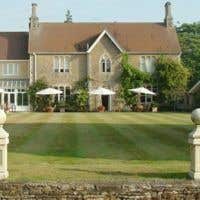This article was also published in the Financial Times.
For such a visitor magnet, Oxford has long been relatively short of seriously attractive places to stay and eat. We set off to explore a new possibility in the countryside south of the city, via lunch overlooking it.
The modern, glass extension to the Ashmolean Museum, conceived by the architect Rick Mather, now provides a bright, sunny location for its top-floor restaurant. A colourful salad of herring, beetroot and sour cream; cannelloni stuffed with leeks; and a bottle of Riesling made by Jochen Dreissigacker in Rheinhessen were an excellent prelude to the colours on show at the Cézanne and the Modern exhibition from the collection of the late American industrialist Henry Pearlman.
A five-minute walk brought us to the Oxford Castle quarter, where groups of foreign schoolchildren were putting their heads into the stocks once reserved for criminals in the Middle Ages. We put our own heads into the Malmaison Hotel, a prison in Victorian times, before repairing to the terrace of 1855, an exciting wine bar recently opened by Alistair Cooper. Alongside a menu that incorporates local cheeses, charcuterie and several uncomplicated hot dishes, Cooper has collated a wide-ranging wine list that offers a range of intriguing wines by the glass from ambitious winemakers in, most notably, Hungary, Turkey, Sicily and Chile.
Suitably refreshed, we then walked into the bus depot nearby, paid £3.40 each for a ticket on the 66 bus to Swindon, asking the driver to drop us off in Kingston Bagpuize with Southmoor. It duly deposited us on the doorstep of Fallowfields Hotel, a property that we certainly did not appreciate at the time dates back to AD 958, when it belonged to King Eadwig.
In the intervening centuries the building (photo above taken from the Fallowfields website) has been a farm, a tavern, a home for prisoners of war, and for the past 20 years a hotel, owned by Anthony and Peta Lloyd. It was their cars, I assume, with the number plates B6 FAL and C6 FAL that were parked by the entrance.
Other than the aromas from the kitchen, the front of the hotel is unprepossessing, but once we were ensconced in room 4, which exudes British gentility rather than great luxury, we became aware of the building's attractions over the centuries.
Our view was of an extensive, well-kept garden with a ha-ha. Beyond that was a large paddock into which the current owners have obviously invested a huge amount of capital to provide everything that enthusiastic cooks could want to satisfy hungry customers.
In full view were a large vegetable garden; an orchard in which, we were told, rare fruit trees are planted; a large paddock through which we strolled past a small herd of stocky Dexter cattle; and, dotted around, were pens of ducks, hefty pigs and chickens, which were to provide first-class material for the following day's breakfast. Everything seemed on hand for the kitchen, under chef Matt Weedon, to deliver a really first-class meal.
He is clearly talented, but at 10 pm we left the dining room disappointed, without any member of staff on hand to say good night or thank you. This small but essential touch may have been an oversight, although we did notice that for the previous half an hour the restaurant manageress had been entirely absent, leaving the seven tables of diners not in her care but that of an energetic, but much less experienced, Italian waitress.
I think, however, that the root cause of this disappointment may be more fundamental, particularly as I have noticed this failing elsewhere. Because the focus of so many is now on the sourcing of the ingredients, too much importance is being given to what the plate looks like rather than to how the customer is made to feel and is cared for. Too many cooks can spoil the broth; too little warmth and attention can be equally underwhelming.
Fallowfields makes this dialogue easier for themselves by phoning the day before, ascertaining exactly what time we would like to eat and then agreeing a time when we would come down to the bar for a drink, canapés and for our order to be taken. Armed with this knowledge, the hotel staff should be on the front foot but they weren't.
Weedon's menu, and regrettably he never put his head out of the kitchen, is extensive, well balanced, rather verbose but intriguing. Certainly, our two first courses, a ravioli of egg yolk and truffled potato with wild mushrooms, grilled artichokes and Parmesan and an unlikely but successful combination of grilled mackerel and a confit of pork with lime and cucumber were very good indeed. So too was an amuse bouche of Jerusalem artichoke and pear in a cone and their home-baked breads.
But despite an excellent bottle of Grenache 2012 made by David Sadie in Swartland, South Africa (£63 from a well-priced list), our main courses were more disappointing. The simultaneous serving of the two parts of the beef main course, tartare and bouillon, plus a plate of sirloin and cheek, made it logistically tricky to enjoy either. The bouillon itself was on the greasy side, the chowder with the sea bass too thin. The dessert menu, of which three out of the four feature chocolate, needs a rethink.
Worst of all, however, was the music, possibly the most jarring I have ever been subject to in any restaurant. This restaurant needs to look after its customers as assiduously as the kitchen looks after its suppliers.
Ashmolean Dining Room Beaumont Street, Oxford 0X1 2PH; tel +44 (0)1865 553823
1855 Wine Bar 4 Oxford Castle, New Road, Oxford OX1 1AY; tel +44 (0)1865 247217
Fallowfields Hotel Farringdon Road, Kingston Bagpuize, Oxon OX13 5BH; tel +44 (0)1865 820416

